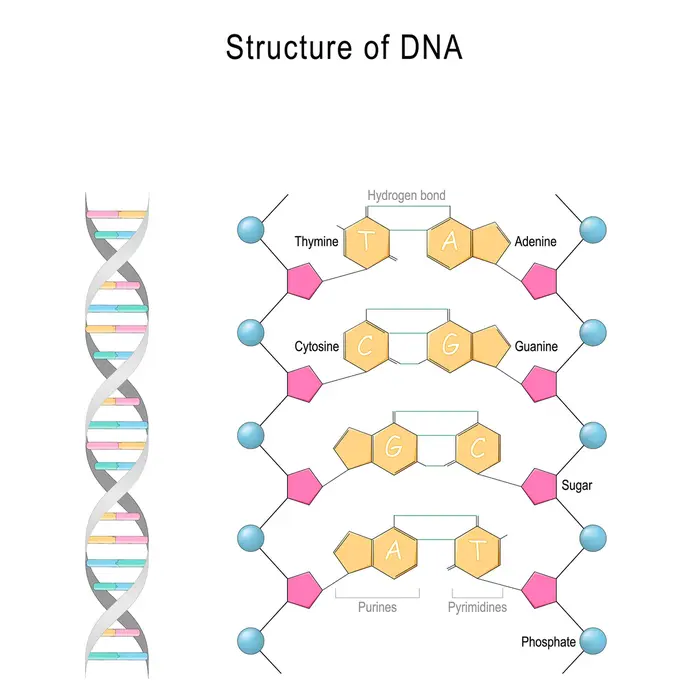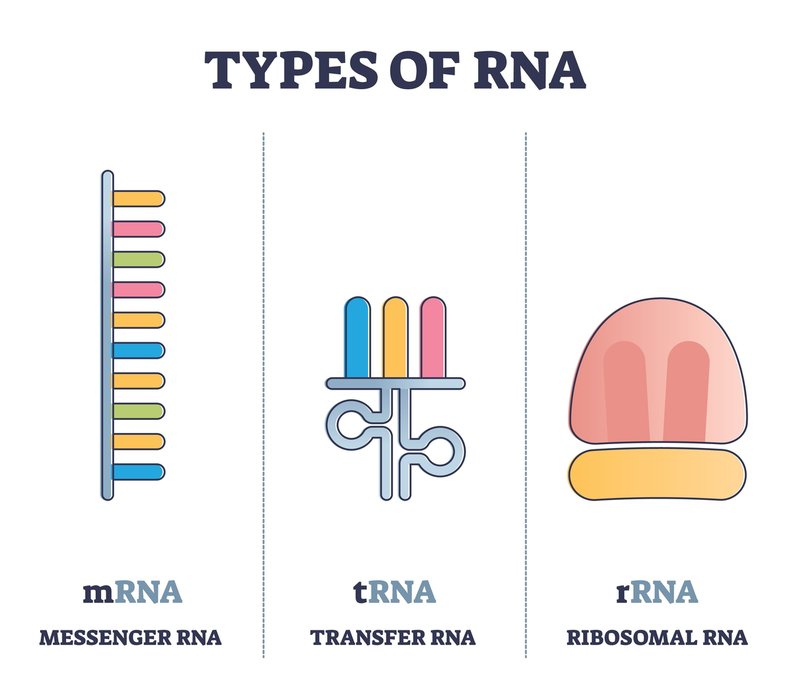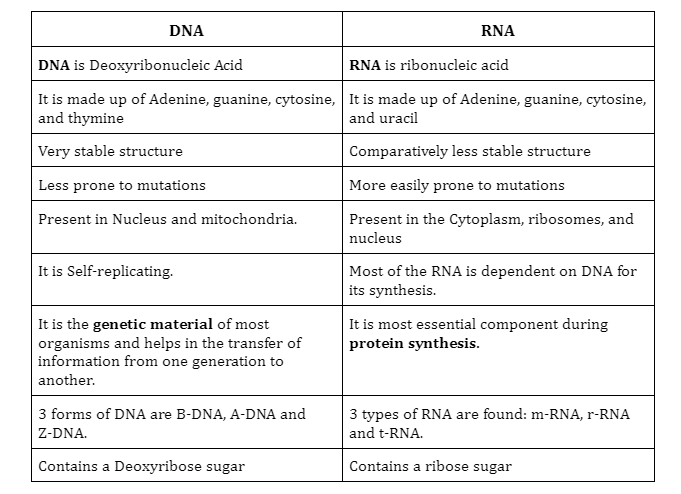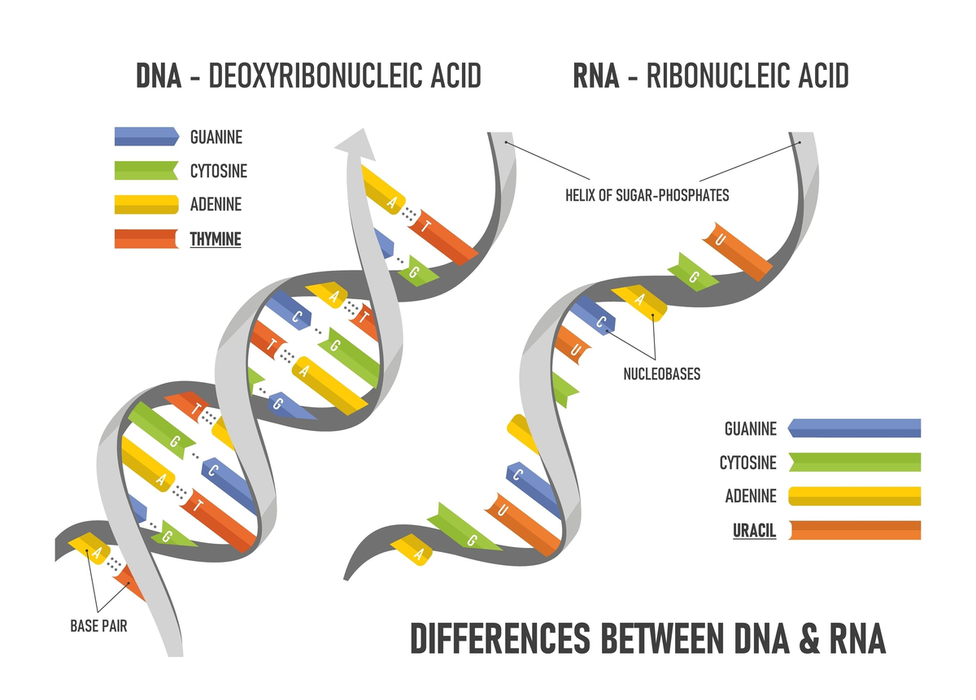Introduction
Different metabolic processes are carried out by organisms in order to ensure their existence and to produce progeny. Naturally occurring macromolecules i.e. nucleic acids hold genetic information.RNA and DNA are both types of nucleic acids. These are nucleotide-based macromolecules. DNA is the genetic substance that contains the genetic instructions for unique traits that are expressed as various characters by organisms.
Some viruses have RNA as their genetic material. Almost all cells contain RNA, which plays a specific role in protein synthesis.
DNA
- Deoxyribonucleic acid, usually referred to as DNA, is the genetic substance found in many organisms.
- It is a simple, tightly wound circle in the cytoplasm of prokaryotes.
- In the cell nucleus of eukaryotes DNA is tightly wound into chromosomes.
- Despite being long polymers, nucleic acids are tightly wrapped to fit inside the small cell.
- Even in massive multicellular animals, every cell in the body contains the same copy of DNA.
- During replication, the tightly wound structures are unwrapped to create copies.
- Eukaryotes also have mitochondrial DNA, which codes for proteins exclusive to mitochondria, in addition to the nucleus.
Composition
- The nucleic acids are long polymeric chains of individual nucleotides.
- The phosphate group, pentose sugar moiety, and a nitrogenous base are all components of nucleotides.
- There are 4 types of nitrogenous bases found in DNA; adenine and guanine are purines while thymine and cytosine are pyrimidines.
- Deoxyribonucleic acid, or DNA, is made up of long chains of individual deoxyribonucleotides connected by phosphodiester linkages.
- The arrangement of nitrogenous bases corresponds to the arrangement of long chains of nucleotides in a DNA, this sequence encodes the information on DNA and is original to an organism.
Structure
- DNA forms a right-handed double helix with an antiparallel orientation of the two polynucleotide strands. DNA structure resembles a twisted ladder shape.
- The sugar and phosphate groups make the vertical stands of the twisted ladder shape and nitrogenous base pairs resemble the rungs of a ladder.
- The 3′ carbon of one sugar and the phosphate group linked to the 5′ carbon of the subsequent sugar moiety form a phosphodiester linkage.
- Because of this, the connection is sometimes known as a 3′–5′ phosphodiester linkage.
- A glycosidic bond attaches nitrogenous bases to the first carbon of the sugar.
- Through hydrogen bonding, the nitrogenous bases of opposing strands bind with each other.
- Three hydrogen bonds link cytosine and guanine, while two hydrogen bonds pair adenine and thymine. This is known as complementary base paring.
- The double-helical DNA is twisted with 10 base pairs per turn.
- The deep major grooves and shallow minor grooves are created by these helical turns.

Types of DNA
There are two types of DNA depending on where they are located in the cell. The two types of DNA are-Nuclear DNA and Mitochondrial DNA
- Nuclear DNA- Exists as chromosomes in the nucleus. It is huge and is in response of nearly all the characteristics of an organism.
- Mitochondrial DNA- DNA found in mitochondria is known as mitochondrial DNA. This DNA primarily codes for proteins needed for the mitochondrial activity. It originates from the female parent and manifests in the mitochondrial matrix as small circular shapes.
RNA
- RNA is also known as Ribonucleic acid.
- Phosphate group, pentose sugar moiety (ribose), and nitrogenous base are all components of ribonucleotides.
- The ribonucleotides include adenine, guanine, cytosine or uracil.
- RNA can be found as single or double-stranded.
- Nearly every cell has RNA, which serves an important role in protein synthesis.
- RNA serves as the genetic material in several viruses.
Types of RNA
There are three types of RNA found. They are
mRNA or messenger RNA
- mRNA is formed from DNA through transcription. The base pairs of m-RNA are complimentary to base sequences on DNA.
- The nucleotide sequences of mRNA are organized into triplets called codons.
- While several codons can code a single amino acid, each amino acid has a unique codon.
- 64 codons encode twenty amino acids.
- Pre mRNA, a direct byproduct of transcription, undergoes post-transcriptional modifications to become mRNA.
- A guanine group and poly-A tail are added to the pre-mRNA during post-transcriptional modifications to make it more stable.
- The mRNA is the main precursor of protein synthesis.
- It delivers the genetic information from the DNA for protein synthesis.
rRNA or ribosomal RNA
- They are found in ribosomal subunits along with proteins and enzymes.
- The primary component of ribosomes is ribosomal RNA (rRNA).
- It enables the formation of peptide bonds between two amino acids during protein synthesis.
- It also ensures that the mRNA and ribosomes are properly aligned during protein synthesis.
tRNA or transfer RNA
- tRNA is important for protein synthesis.
- During translation, amino acids are transferred by the tRNA.
- Each amino acid has a unique tRNA that transports it to the translation site (ribosome).
- It is the smallest of all RNA.
- tRNA has a structure resembling a clover leaf.

Role in protein synthesis
- Translation is also known as protein synthesis and it occurs in the ribosomes.
- Proteins are long polypeptide chains that are formed when individual amino acids bind to one another through peptide bonds.
- Each of the three RNA types plays a distinct role in translation-
- Single-stranded mRNA contains the instructions needed to make proteins.
- tRNA interprets the genetic code on the mRNA and the specific amino acids are transported from the amino acid pool to the translation site.
- The ribosomal RNA (rRNA) carries out translation by creating peptide bonds between different amino acids.
Difference between DNA and RNA
| DNA | RNA |
DNA is Deoxyribonucleic Acid | RNA is ribonucleic acid |
| It is made up of Adenine, guanine, cytosine, and thymine | It is made up of Adenine, guanine, cytosine, and uracil |
Very stable structure | Comparatively less stable structure |
Less prone to mutations | More easily prone to mutations |
Present in Nucleus and mitochondria. | Present in the Cytoplasm, ribosomes, and nucleus |
It is Self-replicating. | Most of the RNA is dependent on DNA for its synthesis. |
It is the genetic material of most organisms and helps in the transfer of information from one generation to another. | It is most essential component during protein synthesis. |
3 forms of DNA are B-DNA, A-DNA and Z-DNA. | 3 types of RNA are found: m-RNA, r-RNA and t-RNA. |
Contains a Deoxyribose sugar | Contains a ribose sugar |


Summary
The nucleic acids in living things are DNA and RNA. They are organic polymers that are found in nature. Long chains are created by linking the individual nucleotides together with phosphodiester linkages. In the majority of species, DNA, which is found in the nucleus of the eukaryotes, is the genetic information carrier. In order for the long polymeric chains to fit into the smallest microscopic cells, they must be folded numerous times. RNA primarily functions in protein synthesis. The existence of nucleic acids results in the continuation of life and the performance of particular tasks.
Frequently Asked Questions
1. Difference between 3 forms of DNA.
Ans:
| B-DNA | A-DNA | Z-DNA |
| 92% relative humidity | 75% relative humidity | High and low salt concentrations |
| 10bp | 11bp | 12bp |
| Right-handed | Right-handed | Left-handed |
| Widest of all | Width 2nm | Narrowest |
| Most common and stable form | Metastable form | Unstable and has Zig-zag pattern of phosphodiester backbone. |
2. What is central dogma?
Ans: The central dogma is a theory of molecular biology that states that genetic information can only move in a single direction i.e from DNA to RNA to protein. This protein synthesis takes place via three process-
- Replication- This multiplies the DNA stands.
- Transcription–This makes mRNA which encodes information of the DNA.
- Translation- This makes the final proteins that perform various functions in the body.
3.What is a chromosomes?
Ans: The DNA molecule is packed into chromosomes, which are thread-like structures found in the nucleus of every cell. Each chromosome is constructed from DNA that has been tightly wound around proteins called histones which assists in supporting entire chromosome structure.